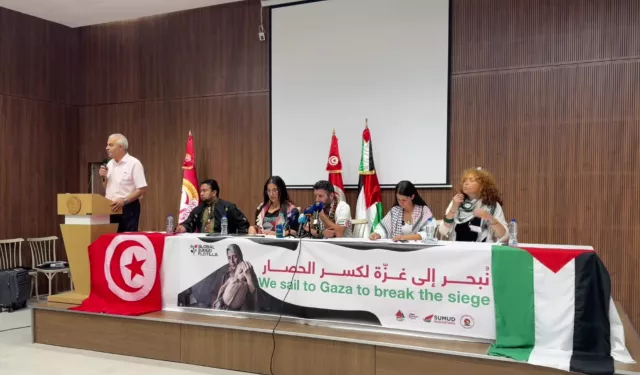An international coalition of activists is preparing to launch what it is calling the “largest civilian fleet in history” to Gaza on August 31, with the aim to break Israel’s blockade and draw global attention to what the groups describe as international complicity in a genocide against Palestinians.
The announcement comes roughly ten days after Israeli occupation forces intercepted the Gaza-bound ship Handala in international waters — following their earlier seizure of the Madleen in similar circumstances. These mark the latest in a series of interceptions targeting vessels operated by the Freedom Flotilla Coalition attempting to reach Gaza.
The upcoming campaign was announced at a press conference held Monday at the Tunisian General Labour Union headquarters in Tunis. Organizers from more than 44 countries attended, including representatives from Asia, Latin America, Europe, and North Africa.
According to the organizers, the campaign plans to dispatch dozens of civilian boats toward Gaza, beginning with a flagship launch from Spain on Aug. 31. Additional departures are scheduled from Tunisia and other countries on Sept. 4, according to flotilla organizers.
The latest campaign unifies three previously distinct efforts under a single coordinated action, including past Freedom Flotilla participants such as Thiago Ávila and Yasemin Acar, who were previously detained and deported by Israel after attempting to sail to Gaza aboard the Madleen.
The coalition also includes the Global Movement to Gaza, formerly known as the Global March to Gaza. The group had attempted to rally international land convoys toward the Rafah border in June, but was blocked and deported by Egyptian security forces for failing to carry proper authorization.
Also joining the coalition is the Maghreb Sumud Convoy, a regional overland mobilization that was organized in June. The convoy aimed to reach Rafah by land but failed to cross the Libyan border.
A new Southeast Asian bloc called Sumud has also joined, comprising Indonesia, Pakistan, the Maldives, Sri Lanka, Bangladesh, Thailand, and the Philippines.
According to Muhammad Nadir Al-Nuri, a spokesperson for the Asian coalition, the bloc is endorsed by Malaysian Prime Minister Anwar Ibrahim and is scheduled to launch its regional convoy on Aug. 23.
He added that the bloc plans to organize a convoy of 5,000 vehicles across the region before setting sail for Gaza.
Other speakers also confirmed plans for land mobilization, asserting that the movement is only possible if people from all around the world come together.
“Just to remind everyone, this is not about a mission. This is a global uprising, a global solidarity movement,” said Saif Abukeshek, one of the organizers of the Global March to Gaza.
In line with this philosophy, he called for a global mobilization on August 9 to “pressure all complicit countries.”
The call was echoed by Acar, who announced, “And even the people that will not be on board, we will mobilize globally. And we will deliver the much-needed humanitarian aid, and we will open a humanitarian People’s Sea Corridor.”
Aid access in Gaza remains perilous amidst a famine worsening at an unprecedented level, according to Gaza’s Government Media Office, affecting 2.4 million people. So far, 133 starvation-related deaths have been reported, including 87 children.
Gaza’s Health Ministry reported last week that seven people, including children, died of hunger or malnutrition in the previous 24 hours, bringing the total famine-related death toll to 154—of whom 89 were children.
Adding to the humanitarian catastrophe, Israeli strikes have killed 1,330 aid-seeking Palestinians and wounded over 8,800 since late May, when the aid foundation began operations.
This violence extends to daily bombardments by Israeli occupation forces at aid distribution points, involving direct fire, aerial attacks, and even reported orders for aid trucks to run over displaced individuals seeking assistance.
